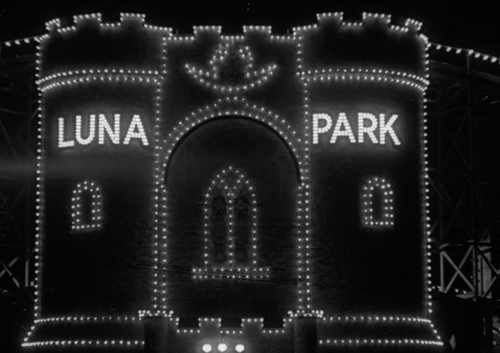
Home to the Big Dipper rollercoaster, dodgems and ‘The Goof House’, Luna Park was a popular leisure attraction. The fun and excitement are captured with incredible clarity in a recently scanned film from the Ngā Taonga collection.
Recorded by pioneering filmmakers the Coubray Brothers in 1928, Luna Park was shot as an advertising feature to help promote the theme park. Richard Falkner, Senior Film Archivist at Ngā Taonga says, “The film looked good, it was really well shot. In terms of style, it reminded me of a Pacific Magazine, a newsreel series from the 1950s.”
The film had been digitised previously but the quality was not good. The older scan was created across several generations: a telecine scan to 1-inch video tape, transferred to Betacam, transferred across several VHS tapes, then a digital file was created from this. Each generation of copying introduced more degradation. This new scan was taken direct from the original nitrate negative with the high-quality ARRIScan film scanner. The contrast between this scan and the older one is dramatically shown below.
A comparison of old and new scans of Luna Park.
The footage was taken using a large, heavy 1920s camera. Filmmaker Ted Coubray noted, “This film was shot by my brother Fred. The interesting thing is that it was shot with a hand cranked camera. How Fred managed to keep his camera firm during the ups and downs on the Big Dipper is beyond me”. (1)
The park opened on 4 December 1926. Regarding the Big Dipper, the Auckland Star on 6 December 1926 noted: “On Saturday afternoon and evening it carried over 6000 passengers, many of whom were so thrilled that they patronised the railway not once, but three or four times”.
At Ngā Taonga, Falkner works primarily with the film scanner. His colleague and fellow Senior Film Archivist, Gareth Evans, handles the grading – this ensures the frames are stable between different shots and the colours are consistent. “Apart from stabilising some shots, the whole process came together easily,” Evans says. “The film preparation, scanning and quality check took about two-and-a-half days altogether. The hardest part was stabilising each shot. Many of the shots have everything in the frame moving, so it required some creative stabilisation. The scan was at 5700 × 4290 resolution, which is measured in square pixels. A resolution of 5700 × 4290 is 24,453,000 pixels of information. For comparison a 4k Ultra High Definition TV is 3840 × 2160 or 8,294,400 pixels. The file size for each scan version was 500 gigabytes.”
“I think it’s especially interesting to anyone who’s spent time in Auckland,” says Evans. “You can figure out where it was. It’s mind-blowing that there’s nothing left of such a large park.” Take a guess and click here to see a map of where Luna Park was located.
The park had a mobile history. “The Big Dipper came from the Dunedin Exhibition of 1925-26 and was reassembled on the Auckland waterfront,” said Coubray. It would later be packed down and moved across the Tasman.
Both the Coubrays’ advertising pitch and the park itself proved unsuccessful. After just four fun-filled years, it closed in February 1931 and much of the contents were moved to Sydney, where Luna Park is still open.
Many thanks to Timespanner for their research into this topic, including contemporary newspaper reports and providing a definitive location of the park.
(1) Ted Coubray quotes are taken from correspondence with him collected in our online catalogue.
Hero image: screengrab from Luna Park (1928).